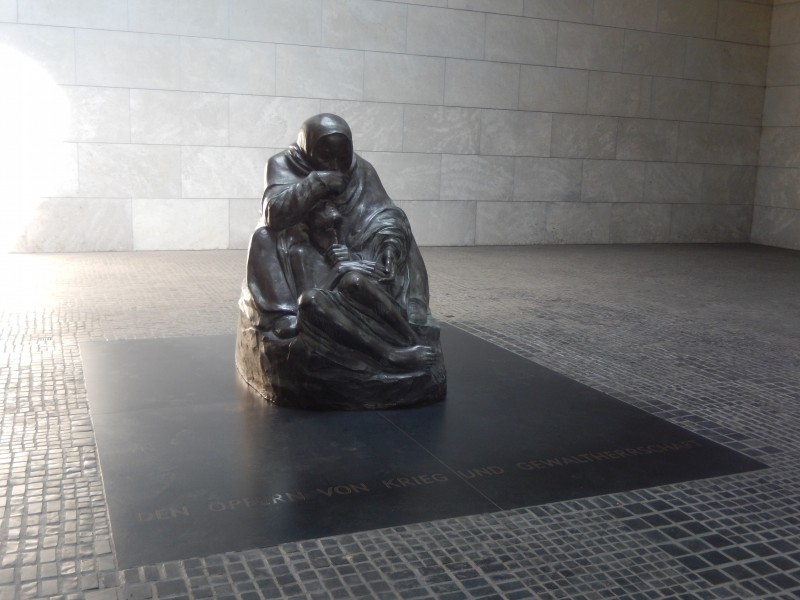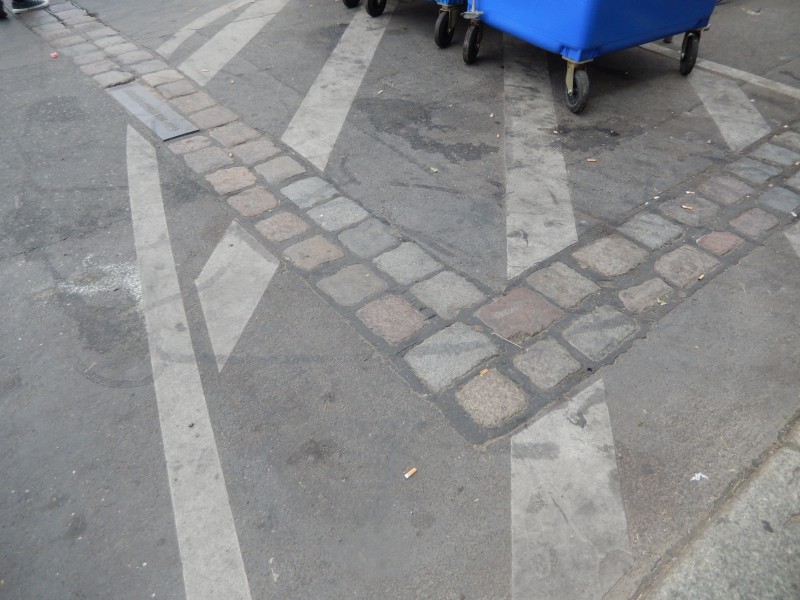Berlin has a dark history as a result of World War II. More than 60 percent of the city was destroyed by bombs. After the war, the country and Berlin were the spoils divided among the victors: Russia, Britain, France, and the U.S.
The history of the concentration camps lingers, and Berlin is not trying to forget it. There are memorials to five groups of people who were sent to the camps: Jews, gypsies, homosexuals, physically and mentally handicapped people, and pacifists. The city is dedicated to learning from history and has made a resolution and created a sculpture to affirm that there will never again be a war started by Germany. There is another very moving sculpture dedicated to those who have lost their lives in all wars. it portrays a woman holding her dead son.

The open roof of the memorial building exposes the sculpture to the elements, symbolic of the woman’s suffering.
Our tour guide’s father was sent to a concentration camp for being a pacifist; his aunt lived in East Berlin and could not go to West Berlin to visit the family until the Wall came down. Yet, the overall outlook of our guide and of Berlin is very positive. Unlike Gdansk, Berlin rebuilt with modern structures, so it looks like a contemporary city. Most of the city buildings are less than 60 years old, having been rebuilt in the 1950s.
The Berlin Wall was literally built overnight. More than 18,000 Nazi soldiers were guarding the East-West city boundary of barbed wire. One night, those soldiers were ordered to build the wall. As people saw the construction, they jumped over the temporary barbed wire fence to escape. Many were shot.
There were actually two walls–an inner one and an outer one–with about the width of a city street between them, and they surrounded all of West Berlin. Why two walls? Because it was easier to defend two lower walls with an open space between them than one higher wall that required only one attempt to escape. The Germans called the open area a security strip; the West called it the death strip. Why surround the western sector? Not to keep the East Berliners inside, but to prevent them from entering West Berlin. Parts of the Wall remain as memorials and there is a double row of bricks following the line where the wall stood, so that everyone can see where it was.

Some of the Wall was left standing and citizens were invited to paint murals on it. This portion portrays the stream of people coming through the crumbled Berlin Wall.

This is an undecorated portion of the original Berlin Wall.

The double row of bricks marking the placement of the 90 miles of the Berlin Wall.
The American Checkpoint Charlie was so named because it was the third checkpoint–Alpha, Bravo, Charlie. In fact, it had little significance because it was never a true checkpoint. If the American soldiers saw someone passing into East Berlin, their attitude was “So long, have a nice day.” If someone was entering West Berlin, the response was “Welcome.” It was only on the East that the Wall was significant. Today, the real building from Checkpoint Charlie is in a Berlin museum. The building on the street is a small fake. The soldiers “guarding” the fake checkpoint are, in fact, university students earning extra money to pose with tourists.

This is the fake building, complete with fake soldiers, at the real site of the American Checkpoint Charlie (and in front of the real McDonald’s).
The population of Berlin is about three million. Since the end of World War II, about two million Berliners have left the city. During the same time, about two million other people have moved into the city. The result is a new and different Berlin.
The history of Berlin sounds sad and depressing–and it is. Berlin and St. Petersburg are emotionally difficult cities to visit as a tourist. In spite of this, we found Berlin to be a lovely city, filled with positive energy. The hotels and hardships are not forgotten, but Berliners are looking to the future, not the past.

Berlin doesn’t want to forget. This is a “stumble stone,” set very slightly higher than the surrounding cobblestones. Each stumble stone is inscribed with a name and placed in front of the house from which that person “disappeared” in Nazi Germany.